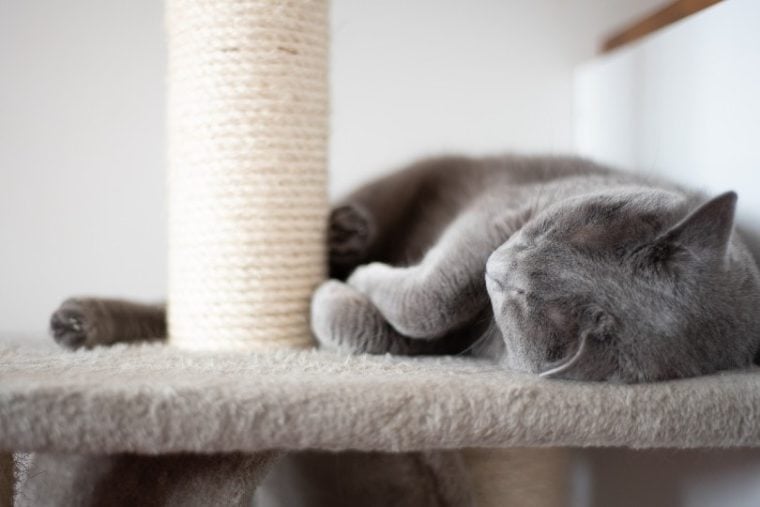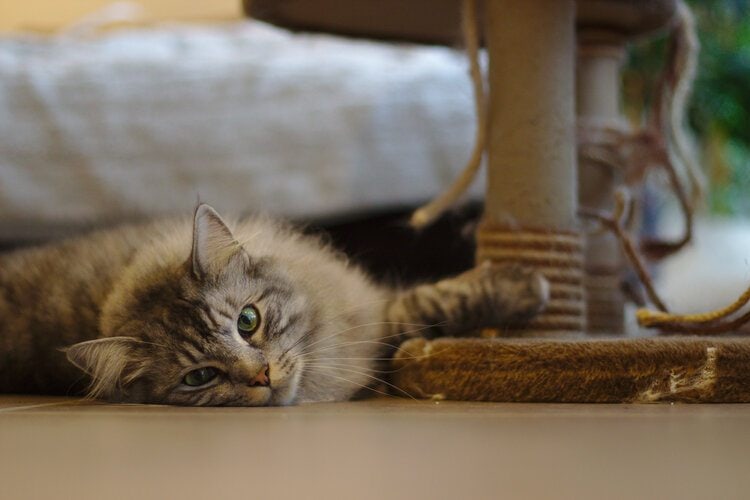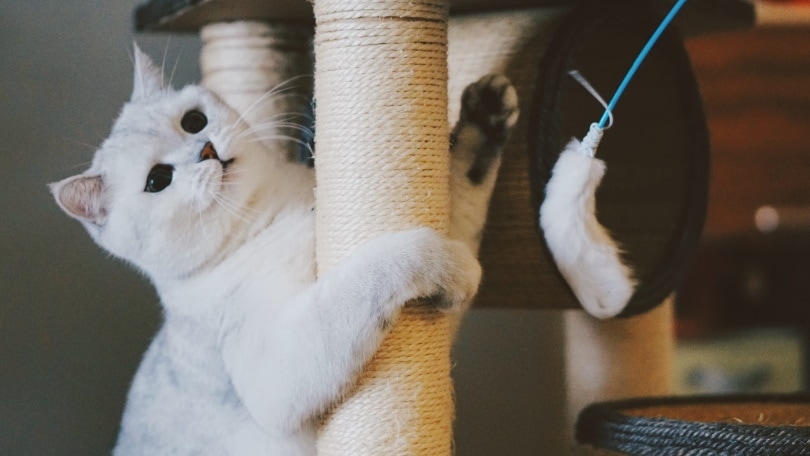
If you own a cat, you are intimately familiar with how much they love to scratch. Your furniture and carpets are also probably familiar with how much they love to scratch.
Owning a cat means stocking up on all kinds of scratching posts to direct them away from our belongings and onto something designed for their claws. But why do cats love scratching so much, anyway? They certainly seem to spend a great deal of time engaged in this rather destructive activity!
Here, we examine this question and give you the answer, along with a few methods that you can use to help reduce your furniture’s appeal to your cat.
The 4 Main Reasons Why Cats Like Scratching Posts
1. Sharpening Those Claws
It is a natural and normal instinct for all cats to scratch. One reason is to sharpen their claws.
Since cats’ claws are retractable, they don’t get worn down while walking, like dogs’ claws. These retractable claws grow in layers, so when cats drag their claws down a surface, it helps loosen and remove the outer husk of each claw, which reveals a new and sharper surface beneath. You’ve probably found these little claw shells lying around the house.
Cats need their claws to escape predators by climbing trees or hunting prey in the wild. While indoor cats don’t necessarily need sharp claws for hunting or escaping predators, the instinct remains. They also come in handy for getting away for a much-needed break from pesky dogs and humans.
Scratching is a normal cat behavior, but that doesn't mean you have to sacrifice your belongings! The right pair of nail clippers can help you keep your cat's nails perfectly trimmed. We recommend Hepper's Cat Nail Clipper Set, which includes two different sizes of stainless steel clippers, a built-in nail file, and a convenient storage pouch. You'll love the comfortable handles, precision blades, and protective safety guard.
At Pet Keen, we've admired Hepper for many years, and decided to take a controlling ownership interest so that we could benefit from the outstanding designs of this cool cat company!
2. Scent Marking
The second reason that cats scratch is scent marking. There are sweat and scent glands between the pads of your cat’s paws that produce a scent that is unique to your cat.
While scratching, the cat deposits this unique scent and leaves those little claw husks behind, giving other cats both a visual and scented greeting card.
But why does your indoor cat care about scent marking when no other cats are around? Inside or out, cats like to claim territory and leave their scent on everything for their comfort and to say hello.

3. Exercising Those Muscles
Scratching allows cats to stretch their muscles. Their legs and spines get a great stretch during the scratching process, which can also help them remain limber.
Cats need to get exercise, including stretching, as it will help them maintain a healthy weight and remain excellent hunters and climbers.
Since the surfaces they choose to scratch on don’t move, it allows them to dig in and use their body weight to get a good scratch going.
4. Emotional Release
Have you ever noticed your cat frantically scratching after a bout of the zoomies? Sometimes, cats scratch as a way to express stress or excitement.
Think of it like you want to punch your pillow when frustrated or dance when happy and excited. There’s no question that our cats can be a little wild at times, and what better way to show us that side of themselves than by a good, frenzied scratching session!

What If Your Cat Doesn’t Use the Scratching Post?
Not all cats like scratching posts and prefer your favorite chair. So, what are the best ways to get your cat off your chair and onto the scratching post?
Finding the Right Scratching Post
It starts by purchasing the right scratching post for your cat. If your cat doesn’t like the post based on the material or position, it won’t get used.
Horizontal or Vertical
The first step is to ensure you get the right kind of scratching post for your cat. Watch your cat while they are in the process of scratching. Does your kitty tend to stretch up on the couch while scratching, or is it a horizontal scratch on the carpet?
Aim for a scratching surface that is in the same position as what your cat seems to prefer. There are many horizontal scratching pads in addition to the usual posts, so aim for the one your cat will be more likely to use.
Height and Length
Similar to the horizontal or vertical option, you need to ensure that you have a long enough scratching surface for your cat. The longer the cat, the longer the scratching post needs to be.
Since cats like to stretch while scratching, if you have a short post, likely, your cat won’t get the same satisfaction from your tall chair.
Material
Scratching posts come in many different materials, with sisal rope, carpet, and cardboard being the most common. Research shows that the ideal scratching post for cats is sisal rope, but cats 10 years or older seem to prefer carpet scratchers.
You might need to do a bit of experimenting. If you have a sisal rope post and your cat doesn’t seem that interested in it, try a carpet or cardboard one.
Sturdiness
Cats enjoy throwing their weight into their scratching, so if the post wobbles, they might be too scared of it falling over to use it. You can either invest in a large and sturdy cat tree that includes long scratching posts or find a post with a large and heavy base. Certain pots can be attached to the wall, so there won’t be any wobbling issues with those.
Making the Scratching Post More Appealing
Now that you have the right kind of scratching post, you still might need to entice your cat to use it. Your cat might take to it, no questions asked, but if not, here are a few tips.
Since most scratching posts are tall furniture, cats are more likely to use them because they also enjoy lounging in high places.
Also, scratching posts that are at least 3 feet in length are more likely to encourage cats to use them.
Having more than one scratching post gives your cat a choice and prevents them from getting bored. This is even more important if you have multiple cats.
Finally, one trick is putting catnip on the scratching post, which might draw your cat to it.

Make Your Furniture Less Appealing
If your cat seems to still prefer your furniture over a cat tree, you might need to make your furniture less appealing.
One way is to use deterrents. There are sprays that are safe to use around cats (avoid anything with undiluted essential oils, as they are quite dangerous for cats).
You can spray it directly on your furniture (check the label in case it isn’t safe for fabric) or near your cat when they start scratching inappropriately. Most of these sprays have a scent that cats won’t find appealing.
You can also put sticky, double-sided tape on the scratch zones. Cats hate anything sticky on their paws, so the moment that they try to scratch, they won’t want to continue.
Eventually, your cat might begin to associate unpleasant smells or stickiness with their favorite chair and might go for the now more appealing scratching post.
Final Thoughts
Scratching is quite important for cats. It’s such an innate and strong instinct, so punishing your cat for scratching something inappropriate won’t work. Positive reinforcement is the right way to go, in addition to using deterrents if your cat is a little on the stubborn side.
Use treats, praise, and pets every time your cat uses the scratching post, and as long as the post itself is the right one for your kitty, you might just save your furniture!
- Related Read: Why Do Cats Like Nail Files So Much? 8 Likely Reasons
Featured Image Credit: husnerova, Pixabay









